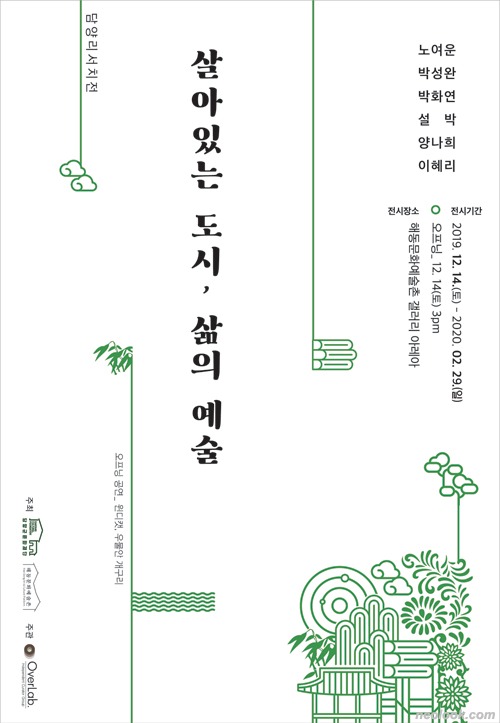
| Period| | 2019.12.14 - 2020.02.23 |
|---|---|
| Operating hours| | 10:00-18:00 |
| Space| | Hae dong culture&art center |
| Address| | 6, Jichim 1-gil, Damyang-eup, Damyang-gun, Jeollanam-do, Republic of Korea |
| Closed| | Mon. |
| Price| | Free |
| Phone| | 061-383-8246 |
| Web site| | 홈페이지 바로가기 |
| Artist| |
노여운,박성완,박화연,설박,이혜리
|
정보수정요청



|
|
Exhibition Information
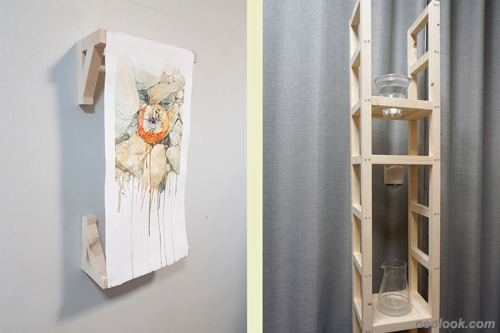
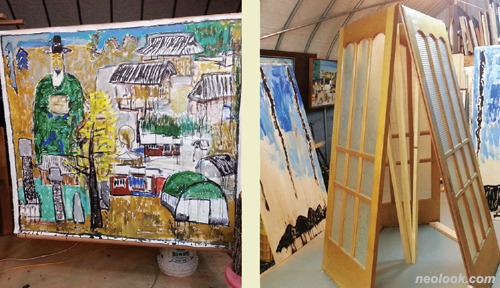
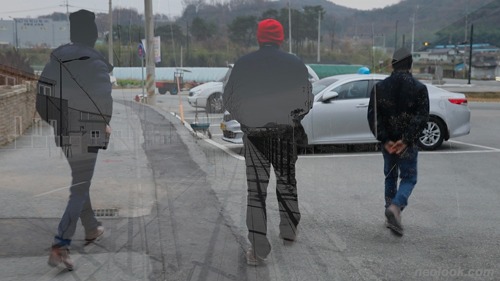
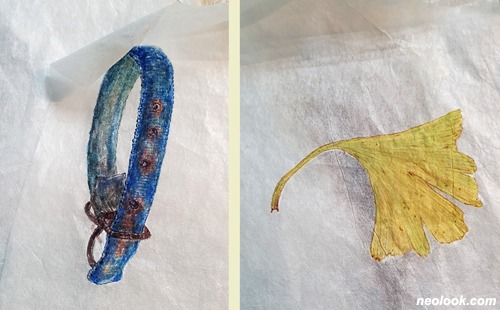
<The Living City, Art of Life> exhibition is an exhibition of Damyang Regional Research, designed to experiment with the implications and possibilities of artistic research, a major creative methodology in modern art. While research generally refers to pre-survey or data collection prior to academic research or work on a subject, it is meaningful as an artistic practice, not just as a methodology of research. Therefore, the <Living City, Art of Life> exhibition aims to present Damyang at various poetry angles through artistic research and interpretation focused on locality, and has a different connotation from the general state festival as a sign of involvement and social role in everyday life and cities by artists. The provision of information through Damyang Cultural Center, along with general historical, cultural and living materials of Damyang, was first made, and the writers' view was added against this backdrop, and the preparation for this exhibition began in earnest. The six participating artists tried to look at Damyang anew, exploring the subject of interest in different eyes and ways. The challenge of being an artist as a researcher is the process of exploring unknown information or refreshing the concept of a place that has been an element of natural life, starting from unfamiliar confusion and obsessions. In the process, however, Damyang's environmental factors, period issues, history and culture led to the production and visualization of non-materials through all the activities that were inspired or in any state of mind. Work through artistic research is an exploration of how it is expressed by artists and what kind of work influence it will have on artists, and an attempt to apply it in practice on the artistic basis of life. I want to reiterate the importance of diversifying perspectives by looking at the various visual outcomes that have been achieved in their own interpretation, as opposed to the general research. Noh Yeo-Un Inspired by the historical and narrative background of the rainwater of the dragon at the research stage, the author collects images along the river that runs through Damyang from the tomb, known as the poet of the Yeongsan River. From Yongso to Buntonggyo Bridge to Daedeok Bridge, collect rivers, natural objects and trash, and solve the impressions of certain phenomena and images encountered in the process by watercolors. In particular, the river water collected after the original Jeong-hwa was purified and used as a material for watercolors. As a search for what is being washed away during the river's journey, the well-to-do, which is assumed to be a river-making component as well, contained a view of the river's stream, which was the center of life. Park Sung-Wan The writer, who moved from Gwangju to Changpyeong’s Egmsil Village after the birth of the child, tried to understand and sympathize with the place he lived in through artistic research. Located at the house of Ryu Jong-heon, a collection village of Munhwa-ryu and a cultural asset No. 192 in Jeollanam-do, the village has a memorial stone for Seokheon Ryu-ok, who served as a spiritual symbol of the Joseon Dynasty's. Against the backdrop of historical and natural elements of the village, the museum showcases paintings that add to the present ashes and objects that contain the traces of life as objects. The installation features a rat rock, a cat rock, and a lion peak (Sam Insan) symbolizing the egg room. Park Hwa-Yeon The writer, who was born and raised in Damyang, presents the work of looking at the present through his personal past in his hometown of Samman-ri. Sammanni is the area where Damyang Industrial Park is located and is inhabited by migrant workers from Sri Lanka. Looking into their lives, the father's history of working abroad in Kuwait and Saudi Arabia 36 years ago overlaps, and by looking into the past of individuals (fathers), he emphasizes the local, local, transnational, connected life and labor styles and the importance of their values. In order to track the changing appearance of the village, the government also sought to find the original plan that was based on mapping and to archive records of changes in the boundary of cultivated land. Seolbak The author, who studies acid-based modern concept arithmetic, says research has given him a new understanding of Damyang. The mountains surrounding Damyang contain various tales, and the stream that runs through the town boasts a beautiful view of the Yeongsangang River’s. The work begins with a view from the top of Boriam, where you can get the best view of it. The ridges surrounding Damyang Lake, the curved ridges of Mt. Jisuk, Mt.San, Mt.San, and Mt.Jeonggak, are embossed and abstract from the author's point of view, and are implemented as installation works for paintings. Also, the consideration of how information from research could be expressed as artistic value was designed to allow the audience to share the specific, professional scenes collected during the process. Yang Na Hee Inspired by the story of Jeon Woo-chi, who studied at Damyang Interlocks, the artist will present installation works featuring Damyang’s main image. The author, who had heard many tales of Damyang during the research phase, noted the mysterious development of the contents as well as the background of the real-life places and life. Damyang's natural and cultural elements are ignited into a new place where reality and non-reality coexist through a writer's interpretation. The scenery of the work, which contains the cool Yongso of the Yeongsangang River, extends into reality, leading to the appearance of Damyang, surrounded by mountains on three sides. Damyang's representative pavilion and pavilion, which are hidden inside, are also represented by Yang Na-hee's unique style of painting. Lee Hye-Ri The author, who has heard stories about Yongso, Binnyeo Rock, and Jeon Woo-chi during the research phase, focuses on the daily lives of Damyang villagers rather than focusing on colorful stories. As the place of life behind the image of a tourist city where people stay for a short rest, they focus on the life of the village and its residents and collect stories and images. Illustrating objects that associate meaning with trivial things, and passing things as they should be, he looks into the "between" of everyday elements that even villagers might have passed. This extends to lines of poetry about emptiness, an interesting subject for the author who collects small daily lives, though hidden between huge or grandeur.
